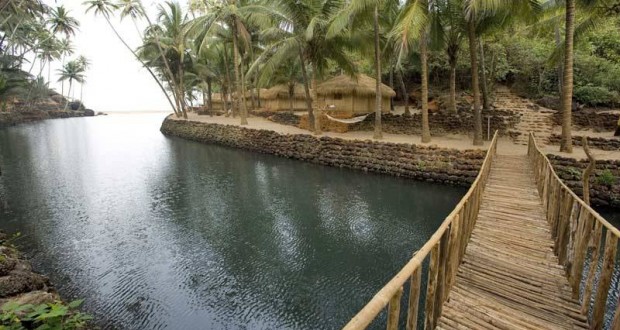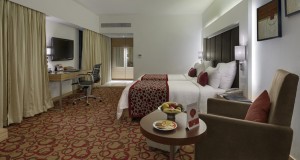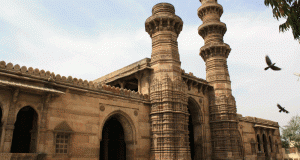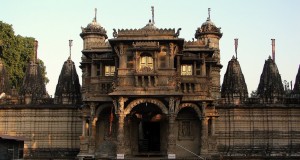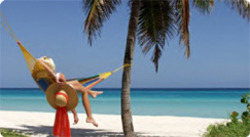 flocked to them in the 1980s (mainly to see the hippies), and two or three of them (notably Cola ) deserve the description of the best beaches in India. There are still miles of unspoilt strands, and an ever-increasing number of first-class resorts.C Because there’s so much choice, the ‘sneak previews’ provided by the Panjim tours can be a real help in selecting the best beaches to visit. But if you’re determined to hit the beaches first thing, here are a few tips. Owing to rapid development, Goa’s beaches are constantly changing, but the following guide should hold true for a while. The three luxury beaches of Majorda, Aguada and Bogmalo may have the best facilities, but are short on social life and laughs; the northern beaches strung close together, easily negotiated by foot) are ideal for those who bore easily —they have the best parties, the cheapest accommodation, and the worst reputation for drugs despite regular police searches; Cola and Benaulim, the extensive southern beaches, are for those in search of complete peace and quiet: here you can walk the whole day without seeing a soul.Beach preparations should include the right equipment—sun-oil, flip-flops, sunglasses,
flocked to them in the 1980s (mainly to see the hippies), and two or three of them (notably Cola ) deserve the description of the best beaches in India. There are still miles of unspoilt strands, and an ever-increasing number of first-class resorts.C Because there’s so much choice, the ‘sneak previews’ provided by the Panjim tours can be a real help in selecting the best beaches to visit. But if you’re determined to hit the beaches first thing, here are a few tips. Owing to rapid development, Goa’s beaches are constantly changing, but the following guide should hold true for a while. The three luxury beaches of Majorda, Aguada and Bogmalo may have the best facilities, but are short on social life and laughs; the northern beaches strung close together, easily negotiated by foot) are ideal for those who bore easily —they have the best parties, the cheapest accommodation, and the worst reputation for drugs despite regular police searches; Cola and Benaulim, the extensive southern beaches, are for those in search of complete peace and quiet: here you can walk the whole day without seeing a soul.Beach preparations should include the right equipment—sun-oil, flip-flops, sunglasses, 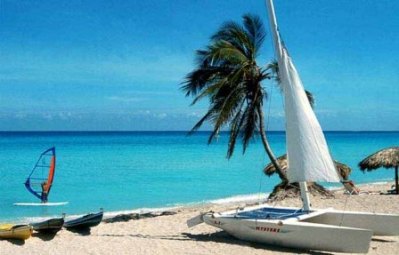 face-mask, etc. (all things people later regret not bringing)—and the right attitude—relaxed, yet not too switched-off (theft, sunburn and drugs are all risk factors). Good sun-oil and sunglasses are not readily available in Goa (although Ray-Bans are now made in India for those wanting to emulate Tom Cruise). Some of the oil sold on the beach will be local concoctions in discarded bottles. Sleeping on the beach is not a good idea. If you are on a really tight budget, local families let out moms at several beaches for a few rupees per night.
face-mask, etc. (all things people later regret not bringing)—and the right attitude—relaxed, yet not too switched-off (theft, sunburn and drugs are all risk factors). Good sun-oil and sunglasses are not readily available in Goa (although Ray-Bans are now made in India for those wanting to emulate Tom Cruise). Some of the oil sold on the beach will be local concoctions in discarded bottles. Sleeping on the beach is not a good idea. If you are on a really tight budget, local families let out moms at several beaches for a few rupees per night.
Northern Beaches
Fort Aguada-Calangute-Baga-Anjuna-Chapora/Vagator-Arambol/Terekol
Fort Aguada
This jet-set resort, notable for its 16th-century fort and apparently endless expanse of white sand, has the best water-sports, the best coastal views and the most famous beach hotel in India. This is the Taj group’s Fort Aguada Beach Resort (tel 0832-87501 /7, tlx 0194-291 TAJ IN, fax 0832-87733). Rooms 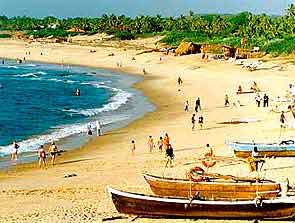 here start at US$50 single in the off season (July, August and September) rising to US$135 during the Christmas and New Year period. The best ones, with excellent views , from large terraces, are in the main block. Good facilities for water-skiing, wind-surfing, para-sailing, fishing and scuba-diving. Right next door is the equally fine Taj Holiday Village (tel 0832-87514/7, above telex and fax) which offers charming beach cottages designed like Goan homes, in a private, romantic setting. Prices start at US$35 in the low season, for a non air-conditioned room in a cottage, and reach US$125 in the high season for air-conditioned rooms. Singles – II bedroom cottages, two-room villas and family units are also available. The high level of service, the excellent facilities and special areas for children make the Holiday Village one of Goa’s best options.
here start at US$50 single in the off season (July, August and September) rising to US$135 during the Christmas and New Year period. The best ones, with excellent views , from large terraces, are in the main block. Good facilities for water-skiing, wind-surfing, para-sailing, fishing and scuba-diving. Right next door is the equally fine Taj Holiday Village (tel 0832-87514/7, above telex and fax) which offers charming beach cottages designed like Goan homes, in a private, romantic setting. Prices start at US$35 in the low season, for a non air-conditioned room in a cottage, and reach US$125 in the high season for air-conditioned rooms. Singles – II bedroom cottages, two-room villas and family units are also available. The high level of service, the excellent facilities and special areas for children make the Holiday Village one of Goa’s best options.
Taj’s 20-villa Aguada Hermitage (tel, tix and fax same as the Beach Resort) was built for the Commonwealth Heads of Government conference in 1982 and is situated on the hillside above the beach resort overlooking the sea. There are four types of Villa with rates ranging from US$100 in the low season to US$425 in the Christmas- New Year period.
Calangute
The old Queen Beach of Goa, where coconut palms once shaded a mile-wide stretch of tranquil orange sands, has been overdeveloped and ruined by unsightly tourist hostels and souvenir stands. Busloads of Indian voyeurs 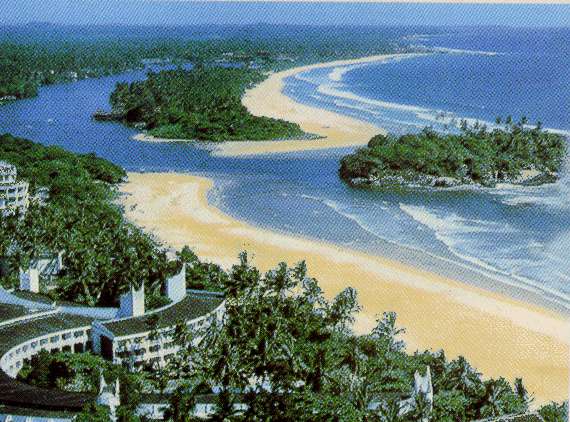 turn up here daily, hoping to photograph Western women unclad on the beaches. Calangute is now a fully fledged Indian holiday resort with popcorn stands, iced-beer stalls, and shifty businessmen, and is both dirty and commercial. Most travellers head straight on to Cola or Vagator, but a few hang around for the ‘action’. This includes a trio of useful travel agencies offering cheap international flights near the tourist office and various stalls selling cheap-and-nasty Indian crafts and good but pricey Tibetan /Rajasthani items. Also, some good eating places like Souza Lobo Restaurant (lovely setting, superb seafood and Indian wine), Wilson’s (on the beach), Alex Cold Drink House (by the statue, with good sounds), Modern Tavern (cheap drinks) and Dinky Bar & Restaurant (nice Goan food, popular travellers’ hangout). The best place to stay is the charming Varma’s Beach Resort (tel 22, 77), behind
turn up here daily, hoping to photograph Western women unclad on the beaches. Calangute is now a fully fledged Indian holiday resort with popcorn stands, iced-beer stalls, and shifty businessmen, and is both dirty and commercial. Most travellers head straight on to Cola or Vagator, but a few hang around for the ‘action’. This includes a trio of useful travel agencies offering cheap international flights near the tourist office and various stalls selling cheap-and-nasty Indian crafts and good but pricey Tibetan /Rajasthani items. Also, some good eating places like Souza Lobo Restaurant (lovely setting, superb seafood and Indian wine), Wilson’s (on the beach), Alex Cold Drink House (by the statue, with good sounds), Modern Tavern (cheap drinks) and Dinky Bar & Restaurant (nice Goan food, popular travellers’ hangout). The best place to stay is the charming Varma’s Beach Resort (tel 22, 77), behind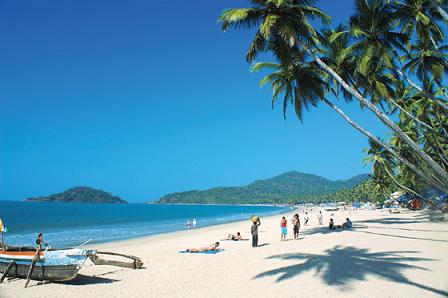 the bus-stand, with lovely gardens and homely air-con rooms with verandahs at Rs250-400. The Concha Beach Resort at Urntawaddo (tel 56, 74, 78) has a good restaurant, decent rooms and all services (Rs200-35). The Tourist Hostel (tel 24) is good value at Rs55 /70, but often full and noisy. If the various other cheapies (mostly unsatisfactory) that you will undoubtedly hear about on the travellers’ grapevine don’t appeal, stay in a family house behind the beach. Families often meet travellers off the bus, and offer clean, simple double rooms. Recommended, but have your mosquito net handy. Buses for Calangute leave from Mapusa every half-hour or so.
the bus-stand, with lovely gardens and homely air-con rooms with verandahs at Rs250-400. The Concha Beach Resort at Urntawaddo (tel 56, 74, 78) has a good restaurant, decent rooms and all services (Rs200-35). The Tourist Hostel (tel 24) is good value at Rs55 /70, but often full and noisy. If the various other cheapies (mostly unsatisfactory) that you will undoubtedly hear about on the travellers’ grapevine don’t appeal, stay in a family house behind the beach. Families often meet travellers off the bus, and offer clean, simple double rooms. Recommended, but have your mosquito net handy. Buses for Calangute leave from Mapusa every half-hour or so.
Baga
As you head north, the beaches become better and better. Baga, overlooked by a high promontory, is a fine example. Just 2 km (11/2 miles) north of touristy Calangute, it is far more secluded and pleasant. Hotel Baia Do Sol (tel 84-86, tlx 0194-303) offers superb recreations (river cruises, water-skiing, yachting and fishing), good entertainments (traditional folk dances and music), great food (at the renowned Seafood Restaurant) and lovely riverside cottages on the seafront at Rs450, and gives a 60% discount in the off-season. Many cheaper rooms too. A good fallback is Riverside Hotel (tel 62), with a charming lady owner, delicious home cooking, and recommended two-person cottages (again, much cheaper in the low season). For relative solitude plus good facilities (it even has a small wind-surfing school), Baga is still the best of Goa’s northern beaches. If you get bored, head into Calangute on a Saturday night, and let off some steam at one of the popular discos.
Anjuna
Just 10 minutes’ walk further north (cross the stream at the top of Baga, walk round the headland 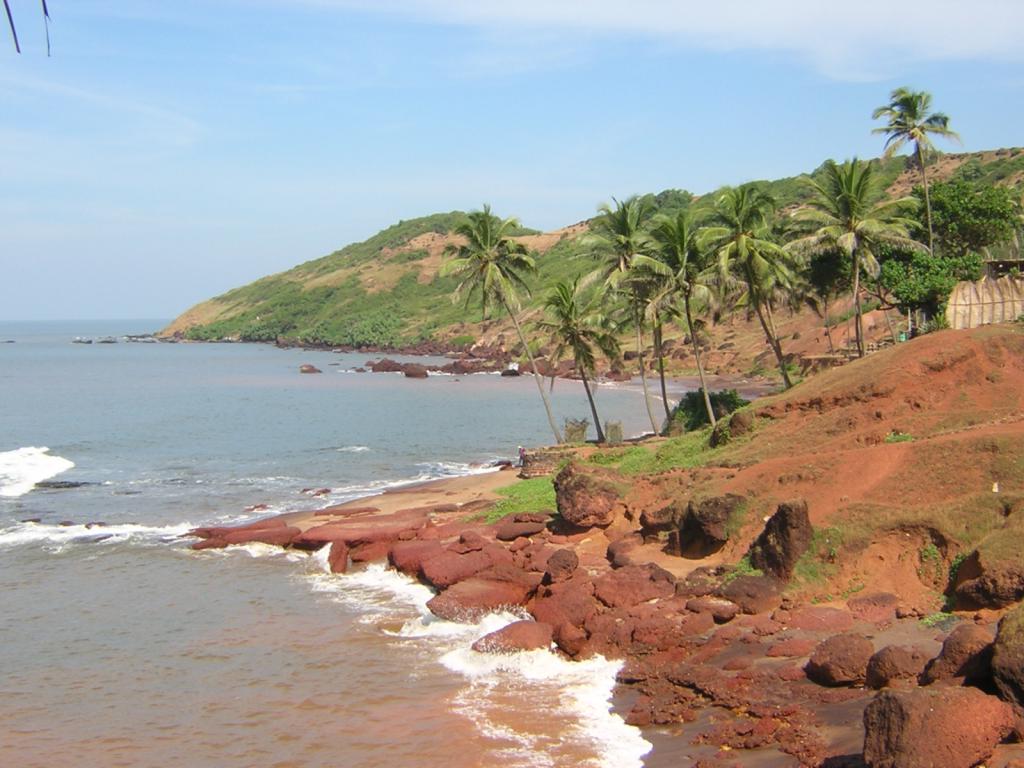 past the chapel) is the ‘freak beach’ of Anjuna. A marvellous place for meeting people, illegal nude bathing, just hanging out, it has big pros and cons. It’s famous for its beach parties, where everyone flips out on psychedelic 1960s music and goes skinny-dipping. Also for its superb Flea Market, which takes place at the southern end of the beach every Wednesday between 2 and 7 pm. This is a great place to sell your unwantedjeans, watch, camera or Walkman. Or to shop around for Tibetan/Kashmiri jewellery, Rajasthani handicrafts, stylish cotton clothing and funky hippie handicrafts. The atmosphere is amazing. The whole of Goa seems to turn up, also loads of Arabs, Chinese and Indians, either to buy Western luxury items or just to ‘see the hippies’. For accommodation, there are just two proper lodges: Poonam Guest House, with overpriced rooms (Rs50-150 and popular garden restaurant; and Parma Sol, on the beach, with two seaview double rooms and some cheaper but huge non-view rooms run by friendly ‘Israel’ Tony (Rs50-150). Most thjuna residents are long-stay, and negotiate very cheap family rooms back off the each. Between November and February, when all accommodation
past the chapel) is the ‘freak beach’ of Anjuna. A marvellous place for meeting people, illegal nude bathing, just hanging out, it has big pros and cons. It’s famous for its beach parties, where everyone flips out on psychedelic 1960s music and goes skinny-dipping. Also for its superb Flea Market, which takes place at the southern end of the beach every Wednesday between 2 and 7 pm. This is a great place to sell your unwantedjeans, watch, camera or Walkman. Or to shop around for Tibetan/Kashmiri jewellery, Rajasthani handicrafts, stylish cotton clothing and funky hippie handicrafts. The atmosphere is amazing. The whole of Goa seems to turn up, also loads of Arabs, Chinese and Indians, either to buy Western luxury items or just to ‘see the hippies’. For accommodation, there are just two proper lodges: Poonam Guest House, with overpriced rooms (Rs50-150 and popular garden restaurant; and Parma Sol, on the beach, with two seaview double rooms and some cheaper but huge non-view rooms run by friendly ‘Israel’ Tony (Rs50-150). Most thjuna residents are long-stay, and negotiate very cheap family rooms back off the each. Between November and February, when all accommodation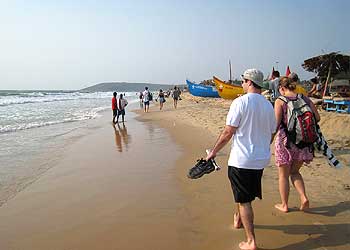 is booked weeks ahead, don’t turn up on spec—unless you’re prepared to sleep on the beach. Anjuna itself is a small, attractive cove, backing onto swaying palms. The sea is very suitable for swimming—except in the afternoon, when it is swept by strong onshore breezes. At this time of day, walk round to the quiet, protected coves between thjuna and Baga—these are beautifully secluded. In the town is the splendid 1920s Albuquerque Mansion. There are only a couple of decent eating places: either Poonam’s, or the Rose Garden Restaurant on the beach. In the town is O’Coqueiro :el 7271), at Porvorim with excellent Goan food. Service at all Anjuna’s restaurants notoriously slow.
is booked weeks ahead, don’t turn up on spec—unless you’re prepared to sleep on the beach. Anjuna itself is a small, attractive cove, backing onto swaying palms. The sea is very suitable for swimming—except in the afternoon, when it is swept by strong onshore breezes. At this time of day, walk round to the quiet, protected coves between thjuna and Baga—these are beautifully secluded. In the town is the splendid 1920s Albuquerque Mansion. There are only a couple of decent eating places: either Poonam’s, or the Rose Garden Restaurant on the beach. In the town is O’Coqueiro :el 7271), at Porvorim with excellent Goan food. Service at all Anjuna’s restaurants notoriously slow.
The most common approach to Anjuna is via local bus or shared cab from Mapusa .s7-5). But some travellers hire motorcycles from Calangute, and bike up. These :an be hired at Anjuna too, for about Rs750 per fortnight, and are a popular—if inury-fraught—method of beach-hopping.
Chapora/Vagator
An 11-km (5-mile) bus ride from Mapusa, these most northern beaches are the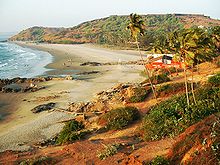 least spoiled and the most secluded. If you tire of Anjuna, they are just a 3-km (2-mile) stroll up along the headland. Vagator is strikingly beautiful, a small cove of rich orange sands embraced by green-gold coconut palms. The small sandy coves of Qtapora adjoining it to the north are overlooked by the old Portuguese Fort (built 1717, now in ruins but worth a visit for the fine views from the ramparts), and back onto a charming little village. The quality place to stay is Vagator Beach Resort (tel Siolim 41), with friendly atmosphere, good restaurant and lovely red-tiled beachview cottages in the garden (from Rs150 /275). Cheapies like Dr Lobo’s or Noble Nest are friendly and clean, but basic. Ask around on the beach for others. Eat either at the big resort hotel; or at Lobo’s on the beach, not at the lodge of the same name in the village. Vagator is another popular haunt of long-stay travellers; most stay at the small ashram run by missionaries. The atmosphere is extremely peaceful: people only rouse themselves for mass bingo (with disco music) in the day, and for cosy open-air parties at night.
least spoiled and the most secluded. If you tire of Anjuna, they are just a 3-km (2-mile) stroll up along the headland. Vagator is strikingly beautiful, a small cove of rich orange sands embraced by green-gold coconut palms. The small sandy coves of Qtapora adjoining it to the north are overlooked by the old Portuguese Fort (built 1717, now in ruins but worth a visit for the fine views from the ramparts), and back onto a charming little village. The quality place to stay is Vagator Beach Resort (tel Siolim 41), with friendly atmosphere, good restaurant and lovely red-tiled beachview cottages in the garden (from Rs150 /275). Cheapies like Dr Lobo’s or Noble Nest are friendly and clean, but basic. Ask around on the beach for others. Eat either at the big resort hotel; or at Lobo’s on the beach, not at the lodge of the same name in the village. Vagator is another popular haunt of long-stay travellers; most stay at the small ashram run by missionaries. The atmosphere is extremely peaceful: people only rouse themselves for mass bingo (with disco music) in the day, and for cosy open-air parties at night.
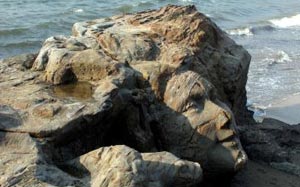 Arambol/Terekol
Arambol/Terekol
These two northernmost beaches are the final retreat of the hippies and the place to get really away from it all. Bring a sleeping bag, just in case you have to sleep on the beach. Arambol has a beautiful freshwater lake (ideal for washing-off after swims in the salty sea), lovely sands, free camping, also beach-huts, and expanses of empty beach. The friendly village close to the main beach has restaurants with reasonable food. Above Arambol, Terekol marks the northern boundary of Goa’s coast, and has a fine fort (now converted to a rest house) with a small church and good views Arambol is 3 hours by bus from Mapusa. A long trip, but worth it.
Southern Beaches-Bogmalo–Colva–Benaulim–Betul
Bogmalo
This is one of Goa’s best beaches, a secluded crescent-shaped cove with calm, safe waters for swimming (a contrast to the powerful breakers of the more open beaches and a friendly fishing village. Behind the beach rises the small upland of the Marmagao peninsula. It is an exclusive beach, presided over (as at Fort Aguada) a single luxury hotel: the Oberoi Bogmalo Beach (tel 2191, 3311/5, 3291 tix 0191-29 OBGA IN, fax 08345-2510).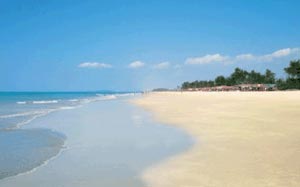 Only 5 minutes’ drive from the airport, this is an excellent holiday option with marvellous water-sports, freshwater swimming-pool, qualit) multi-cuisine restaurants, breezy open-air barbecues, and elegantly furnished rooms (US$85 single, US$95 double in the high season, dropping to US$35 and US$55 in the low season), each one with a private balcony overlooking the sea. Few budget travellers make it out here: transport is too awkward (1 hour minimum by bus from Panjim, with a change at the ‘Aerodrome’ stop 3 km before Vasco) and there’s nowhere cheap to stay. Oberoi lays on free transport from the airport for residents. South of Bogmalo are the Velsao and Majorda beaches. Both remain fairly quiet but the Majorda Beach Resort (tel 20751,20203, tlx 0196-234) set slightly back from the beach has all facilities (from Rs1200).
Only 5 minutes’ drive from the airport, this is an excellent holiday option with marvellous water-sports, freshwater swimming-pool, qualit) multi-cuisine restaurants, breezy open-air barbecues, and elegantly furnished rooms (US$85 single, US$95 double in the high season, dropping to US$35 and US$55 in the low season), each one with a private balcony overlooking the sea. Few budget travellers make it out here: transport is too awkward (1 hour minimum by bus from Panjim, with a change at the ‘Aerodrome’ stop 3 km before Vasco) and there’s nowhere cheap to stay. Oberoi lays on free transport from the airport for residents. South of Bogmalo are the Velsao and Majorda beaches. Both remain fairly quiet but the Majorda Beach Resort (tel 20751,20203, tlx 0196-234) set slightly back from the beach has all facilities (from Rs1200).
Cola
Goa’s longest beach is an unbroken 20 km (12 1/2 miles) of virgin white sand.  Unlike Calangute to the north, Cola has not been spoiled by progress. Here you need only walk a kilometre or two out of the main tourist drag to have the beach all to yourself. The waters are warm and calm, the only people you’ll see are local fishermen, and (unlike anywhere else in India) you can take off all your clothes if you want to, and not attract unwanted attention.
Unlike Calangute to the north, Cola has not been spoiled by progress. Here you need only walk a kilometre or two out of the main tourist drag to have the beach all to yourself. The waters are warm and calm, the only people you’ll see are local fishermen, and (unlike anywhere else in India) you can take off all your clothes if you want to, and not attract unwanted attention.
Cola is a half-hour bus journey from Margao. At the bus-stand there are a few pleasant shops, including Damodar, the place to buy or sell second-hand books. Reading is the main occupation on the beaches, so stock up. Navneeta Handicrafts is the place to buy cool, practical beach clothes. Other good purchases on the beach are beautiful lacquer boxes/eggs and painted shells. Buy cheap, attractive jewellery at Colva’s Full Moon parties which are better than Anjuna, some say, with an illuminated marquee, great music and dancing, and lots of atmosphere. Top-bracket accommodation has now arrived with the Ramada Renaissance Resort (tel 08342- 23611 /2, tix 0196-211; in Bombay call 234672, 2042346) near the Varca Village. The 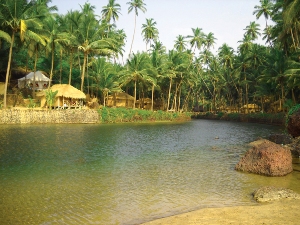 hotel, supposedly designed by Hawaiian architects, has a 6-hole golf course, a series of swimming-pools and direct access to the beach. The sea-facing rooms are from US$95 in the high season. Another new five-star property is The Leela Beach at Cavelossim (tel 6263/70, tlx 0196-258, fax 08344-6352) with rooms in villas and ‘pavilions’ from US$115. Since renovation, prices of rooms at the air-con Hotel Silver Sands (tel 08342-21645, tix 0196-239 SAND IN) have gone up to Rs650 single, Rs750 double, in the high season. Still, you get all the luxury facilities, including swimmingpool, health club, wind-surfing, travel office, free airport transfer. At the bottom end of the range, there’s a choice between two fairly dismal places—the Tourist Hostel and Whitesands Hotel (tel 3253)—and one worthwhile one, Hotel Vincy, above Vincy’s Bar. All three charge from Rsl25. Many people are quite happy to put up at one of the many cheap lodges near the
hotel, supposedly designed by Hawaiian architects, has a 6-hole golf course, a series of swimming-pools and direct access to the beach. The sea-facing rooms are from US$95 in the high season. Another new five-star property is The Leela Beach at Cavelossim (tel 6263/70, tlx 0196-258, fax 08344-6352) with rooms in villas and ‘pavilions’ from US$115. Since renovation, prices of rooms at the air-con Hotel Silver Sands (tel 08342-21645, tix 0196-239 SAND IN) have gone up to Rs650 single, Rs750 double, in the high season. Still, you get all the luxury facilities, including swimmingpool, health club, wind-surfing, travel office, free airport transfer. At the bottom end of the range, there’s a choice between two fairly dismal places—the Tourist Hostel and Whitesands Hotel (tel 3253)—and one worthwhile one, Hotel Vincy, above Vincy’s Bar. All three charge from Rsl25. Many people are quite happy to put up at one of the many cheap lodges near the 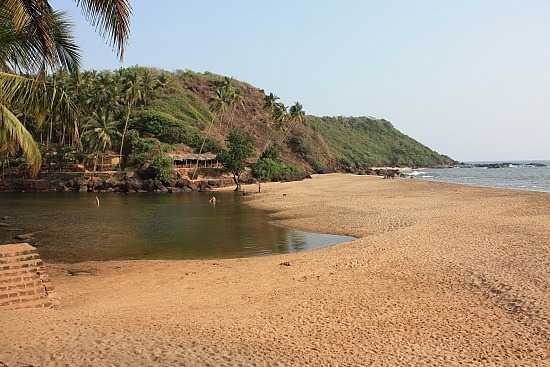 beach—after all, all you really need here is a bed for the night. A couple of goodies are Fisherman’s Cottage (200 m from the bus-station with friendly people) and Rose Cottages. During the high season, when ‘each accommodation is very thin on the ground, try family houses like Sabfran Tourist Cottages (1 km before Cola beach, ask the bus driver to put you off) which charge less than Rsl000 per month for clean, livable double rooms.
beach—after all, all you really need here is a bed for the night. A couple of goodies are Fisherman’s Cottage (200 m from the bus-station with friendly people) and Rose Cottages. During the high season, when ‘each accommodation is very thin on the ground, try family houses like Sabfran Tourist Cottages (1 km before Cola beach, ask the bus driver to put you off) which charge less than Rsl000 per month for clean, livable double rooms.
Most Cola residents eat at one of the ramshackle (but good) beach restaurants II situated right on the shoreline. Regular favourites—all serving excellent seafood in addition to the usual pancakes, chips and omelettes—are Sunset, Lucky Star and La Mir. This is where people come to enjoy tasty fish dishes, spaghetti ‘sizzlers’, and a nightcap feni, after a hard day’s sunbathing. In the morning, they pile over to Umita Corner Restaurant & Bar (away from the beach, near Tourist Nest) for breakfast. There’s always a small gathering around the kiosks by the roundabout at 9 each morning, when hot doughnuts arrive.
Benaulim
If mainstream Cola is too busy for you, stroll 2 km (1 1/4 miles) down the sands to quiet, secluded Benaulim beach. This has a pretty fishing village (about 1 km behind the beach) full of quaint, sleepy old Portuguese houses and buildings. Stay either at L’Amour Beach Resort (near the beach), which has nice, clean rooms with bath (but disappointing , overpriced food), or Brito Tourist Corner at the village crossroads, offering large rooms—like Spanish flats. There are lots of cheaper places, often full. On the beach, eat at Splash Restaurant, which has good service and nice seafood, sbter cluear of tshe potrk sausages. Or try Xavier’s (superlative fish dishes, god Bounds). Pedro’s has gone into steep decline, but Johncy’s still has jolly beach parties. On the walk along the beach from Colva to Benaulim kids turn up to offer people family-house’ accommodation. This can work out remarkably cheap as well as diving an enjoyable insight into the lifestyle of the locals.
secluded Benaulim beach. This has a pretty fishing village (about 1 km behind the beach) full of quaint, sleepy old Portuguese houses and buildings. Stay either at L’Amour Beach Resort (near the beach), which has nice, clean rooms with bath (but disappointing , overpriced food), or Brito Tourist Corner at the village crossroads, offering large rooms—like Spanish flats. There are lots of cheaper places, often full. On the beach, eat at Splash Restaurant, which has good service and nice seafood, sbter cluear of tshe potrk sausages. Or try Xavier’s (superlative fish dishes, god Bounds). Pedro’s has gone into steep decline, but Johncy’s still has jolly beach parties. On the walk along the beach from Colva to Benaulim kids turn up to offer people family-house’ accommodation. This can work out remarkably cheap as well as diving an enjoyable insight into the lifestyle of the locals.
Betul
‘is lovely beach, located on the estuary of the river leading off from the bottom of benaulim,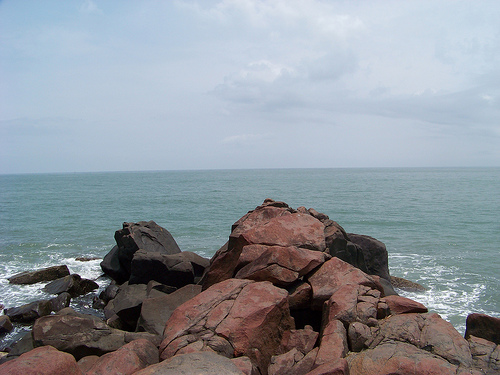 is serviced by buses from Margao. Completely untouched by tourism, just one decent place to stay—a small lodge cum restaurant, run by a friendly Goa.- right next door to an ancestral summer-house. This is a very well-run establishmewith rooms with a balcony overlooking the river from Rs100. It is tricky to find coming in by bus, you still have to walk across the river via the bridge. e – problem is lack of direct access from the lodge to the beaches. You either have a half-hour walk over the hills to a secluded, idyllic beach, or you take a ferry across to the main beach, which runs down from Colva. Betul represents—for the time beir at least—the perfect little getaway for the peace-loving beachcomber.
is serviced by buses from Margao. Completely untouched by tourism, just one decent place to stay—a small lodge cum restaurant, run by a friendly Goa.- right next door to an ancestral summer-house. This is a very well-run establishmewith rooms with a balcony overlooking the river from Rs100. It is tricky to find coming in by bus, you still have to walk across the river via the bridge. e – problem is lack of direct access from the lodge to the beaches. You either have a half-hour walk over the hills to a secluded, idyllic beach, or you take a ferry across to the main beach, which runs down from Colva. Betul represents—for the time beir at least—the perfect little getaway for the peace-loving beachcomber.

